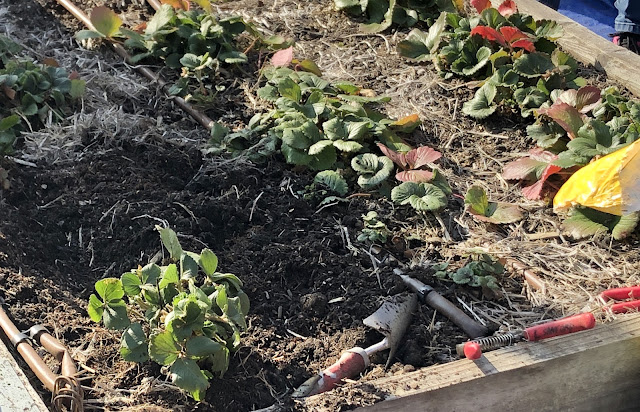
More dry weather creates winter planting window

|
| Not only is it the right time to plant new roots of artichoke, horseradish, strawberry and rhubarb, it's also perfect to clean up and replant older strawberry plants, as above. (Photo: Kathy Morrison) |
How dry we are! Our rainless weather pattern continues.
According to the National Weather Service, Sacramento has a 0% chance of rain between now and next weekend. January, usually one of our wettest months, will end with only 0.05 inches of precipitation – 3.6 inches below normal.
February also is tracking on the dry side. A “normal” February in Sacramento averages nearly 3.6 inches, too.
Right now, the only moisture in the forecast is patchy morning ground fog. That fog will keep temperatures cool, with afternoon highs around 60 degrees and overnight lows in the high 30s.
While we sure could use the rain, make good use of this pleasant winter weather:
* Finish winter pruning. That includes roses and most dormant trees or shrubs.
* This is the last chance to spray fruit trees before they bloom. Treat peach and nectarine trees with copper-based fungicide. Spray apricot trees at bud swell to prevent brown rot. Apply horticultural oil to control scale, mites and aphids on fruit trees soon after a rain. But remember: Oils need at least 24 hours to dry to be effective. Don’t spray during foggy weather.
* Feed spring-blooming shrubs and fall-planted perennials with slow-release fertilizer.
* Fertilize strawberries and asparagus.
* Indoors, start peppers, tomatoes and eggplant from seed.
* Plant bare-root roses, berries and fruit trees.
* Transplant or direct-seed several flowers, including snapdragon, candytuft, lilies, astilbe, larkspur, Shasta and painted daisies, stocks, bleeding heart and coral bells.
* In the vegetable garden, plant Jerusalem artichoke tubers plus artichoke, horseradish, strawberry and rhubarb roots.
* Transplant cabbage, broccoli, kale and Brussels sprouts as well as lettuce (both loose leaf and head).
* Plant seed potatoes and onion sets (small bulbs).
* From seed, plant beets, chard, lettuce, mustard, peas, radishes and turnips.
Comments
0 comments have been posted.Sacramento Digs Gardening to your inbox.
Sites We Like
Garden Checklist for week of July 21
Your garden needs you!
* Keep your vegetable garden watered, mulched and weeded. Water before 8 a.m. to reduce the chance of fungal infection and to conserve moisture.
* Feed vegetable plants bone meal, rock phosphate or other fertilizers high in phosphate to stimulate more blooms and fruiting. (But wait until daily high temperatures drop out of the 100s.)
* Don’t let tomatoes wilt or dry out completely. Give tomatoes a deep watering two to three times a week.
* Harvest vegetables promptly to encourage plants to produce more. Squash especially tends to grow rapidly in hot weather. Keep an eye on zucchini.
* Pinch back chrysanthemums for bushy plants and more flowers in September.
* Remove spent flowers from roses, daylilies and other bloomers as they finish flowering.
* Pinch off blooms from basil so the plant will grow more leaves.
* Cut back lavender after flowering to promote a second bloom.
* It's not too late to add a splash of color. Plant petunias, snapdragons, zinnias and marigolds.
* From seed, plant corn, pumpkins, radishes, winter squash and sunflowers.